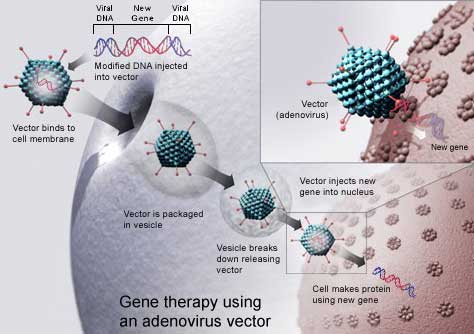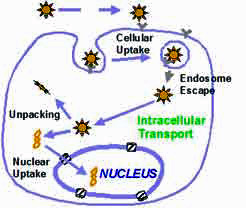| Posted: Feb 09, 2007 | |
Nanotechnology is part of the fight against Alzheimer's |
|
| (Nanowerk Spotlight) There is currently no cure for Alzheimer’s disease and its ultimate cause is still unknown. The disease affects an estimated 4.5 million people in the United States alone. That figure is expected to rise dramatically as the population ages, experts predict. Genetic factors are known to be important in causing the disease, and dominant mutations in different genes have been identified that account for both early onset and late onset Alzheimer's. For a number of years, researchers have been working to alleviate neurodegenerative disorders such as Alzheimer's or Parkinson's disease through gene therapy. In this type of treatment, a gene's DNA is delivered to the neurons in individual cells, allowing them to produce their own therapeutic proteins. Gene therapy typically aims to supplement a defective mutant allele (the location of DNA codings on a chromosome) with a functional one. Currently, the most common carrier vehicles to deliver the therapeutic genes to the patient's target cells are viruses that have been genetically altered to carry normal human DNA. These viruses infect cells, deposit their DNA payloads, and take over the cells' machinery to produce the desirable proteins. One problem with this method is that the human body has developed a very effective immune system that protects it from viral infections. Thanks to advances in nanotechnological fabrication techniques, the development of nonviral nanocarriers for gene delivery has become possible. This is attractive due to the potential for improved safety, reduced ability to provoke an immune response, ease of manufacturing and scale up, and the ability to accommodate larger DNA molecules compared to virus-based delivery tools. | |
 |
Example for viral gene therapy using an Adenovirus vector. A new gene is inserted into an adenovirus vector, which is used to introduce the modified DNA into a human cell. If the treatment is successful, the new gene will make a functional protein. (Illustration: U.S. National Institutes of Health) |
| A number of the people working in nonviral gene therapy used to work with viruses as delivery systems. They had different reasons for turning to nonviral methods, but they do have one thing in common: They saw problems with viral gene therapy. In the early days, even retroviruses were used for gene therapy (HIV is a retrovirus) but later on researchers mostly used adeno-associated viruses, thought safe because they are not associated with human disease. Nevertheless, some scientists think that viruses are inherently unsafe and should be avoided. | |
| Jon A. Wolff, professor of pediatrics and genetics at the Waisman Center at the University of Wisconsin, Madison, used to work with retroviruses, which carry their genetic material in RNA instead of DNA, as a way to deliver genes. But then he realized that viruses had some limitations. "I thought nonviral might be a simpler and easier way of [effecting delivery] and avoid the problems with viral therapy", he says. The main problem is the immunogenicity of the viruses. "Viruses have evolved over a billion years to efficiently deliver DNA into our cells, but our immune system has also evolved over that time," he says (quoted from "Gene delivery – without viruses"). | |
| This is where nonviral gene delivery comes in. By developing nonviral, synthetic nanocarriers from scratch, researchers can design a system that simultaneously achieves high efficiency, prolonged gene expression, and low toxicity. A number of these carriers fulfill one or two of those criteria, but it is difficult to meet all three. | |
 |
|
| Gene delivery is a complex process with many possible rate-limiting steps. After cellular uptake by endocytosis, the gene carrier must traverse the expansive and molecularly crowded cytoplasm to reach the nucleus. The biophysical and biological mechanisms underlying the intracellular transport of gene carriers remain largely unknown, which limits the ability to make rational modifications to gene carriers for improved gene delivery. (Source: Advanced Drug and Gene Delivery Group, Prof. Hanes, The Johns Hopkins University) | |
| Besides the consistent problem of toxicity, synthetic systems such as polymer-, lipid- and peptide-based gene carriers are typically much less efficient in delivering genes to primary neurons compared to viruses. | |
| Research undertaken at The Johns Hopkins University in Baltimore has begun to offer a systematic approach to understanding the gene delivery process in neurons and explore the intracellular barriers to nonviral gene delivery and possible ways to improve their effectiveness with nanotechnology. | |
| "Much work has been done already to improve gene delivery into central nervous system (CNS) neurons to treat neurodegenerative disorders using various gene delivery systems with several therapeutic agents" Justin Hanes, who leads the Advanced Drug and Gene Delivery Group at Johns Hopkins, explained to Nanowerk. "Nevertheless, so far there have been no systematic studies investigating the individual intracellular barriers, which should be the guideline for the design of future gene vectors for CNS therapy." | |
| In a recent study, Hanes and his group systematically examined several potential intracellular barriers that may limit the effectiveness of polymeric gene carriers. | |
| Jung Soo Suk, first author of a paper describing this recent study, elaborates: "In general, potential barriers include cellular uptake, intracellular transport, endosome escape and nuclear import. Based on the mechanistic studies performed by us, we identified cellular uptake as one major barrier that hampers efficient gene delivery in differentiated neurotypic cells." | |
| The paper, titled "Gene delivery to differentiated neurotypic cells with RGD and HIV Tat peptide functionalized polymeric nanoparticles" was published in Biomaterials. | |
| To overcome this cellular uptake barrier, the researchers incorporated targeting peptide (i.e. RGD or HIV Tat-1 peptide) to their polymeric gene carriers to endow them with some desirable "virus-like" properties. They found that attachment of both peptides improves cellular uptake substantially. | |
| Polycationic polymers have shown significant promise as non-viral gene delivery vectors. PEI is currently the most popular polymer used to deliver genes into various cell types, including neurons. PEI is able to condense genes into small nanoparticles and protect the DNA from degradation by nucleases. In addition, the cationic nature of PEI facilitates entry of these gene vectors into cells. | |
| "Surprisingly" says Hanes, "RGD peptide attachment to our gene carrying nanoparticles improved both uptake by neurotypic cells and the escape of the particles from lysosomes. Lysosomes typically degrade gene carriers and prevent them from delivering their DNA payload to the cell nucleus, the target site within the cell for gene therapy." | |
| Hanes cautions that this work is still in its early stages and many more obstacles must be overcome. Suk points out that in order to accomplish the ultimate goal of successful clinical application, a thorough investigation of CNS gene delivery mechanisms in vitro and in vivo must be conducted. | |
| While this research at Johns Hopkins deals with intracellular barriers, gene vectors in practical applications need first successfully overcome several barriers outside the cells before they reach the target cell itself. | |
| "Future work in the line of this study" says Suk, "will include the selection of the optimal administration method and the investigation of extracellular barriers that gene vectors may encounter following the administration. Extensive and systematic approach toward the field will ultimately guide us to design "virus-like" gene vectors without the drawbacks of viruses including safety issues." | |
| Specifically, Hanes sees the research in this field focusing on improved biomaterials that are more efficient while remaining safe to use in the CNS; improved basic understanding of the remaining bottlenecks to efficient gene delivery, both inside the cell and outside; and studying the most promising particles in animal models of disease. | |
 By
Michael
Berger
– Michael is author of three books by the Royal Society of Chemistry:
Nano-Society: Pushing the Boundaries of Technology,
Nanotechnology: The Future is Tiny, and
Nanoengineering: The Skills and Tools Making Technology Invisible
Copyright ©
Nanowerk LLC
By
Michael
Berger
– Michael is author of three books by the Royal Society of Chemistry:
Nano-Society: Pushing the Boundaries of Technology,
Nanotechnology: The Future is Tiny, and
Nanoengineering: The Skills and Tools Making Technology Invisible
Copyright ©
Nanowerk LLC
|
Become a Spotlight guest author! Join our large and growing group of guest contributors. Have you just published a scientific paper or have other exciting developments to share with the nanotechnology community? Here is how to publish on nanowerk.com.
